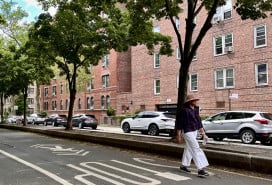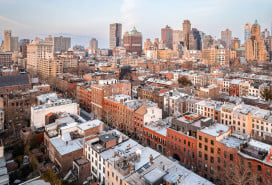The 5 least safe places to live in your building .. and how to stay safer everywhere

When BrickUnderground set out to answer the question “What are the safest and least safe places to live in a building?” we went directly to our expert on security matters, Harry J. Houck, President of Houck Consulting, Inc and a retired NYPD detective.
According to Houck, because of their easy access (and in some cases their hidden nature), these are probably the least safe places to live in a building:
- A first-floor apartment that can be accessed from the lobby
- An apartment with a window within 18-feet of the ground
- An apartment with a fire escape
- An apartment below ground level
- An apartment facing the back of the building (because it's out of plain sight)
But, according to Houck, the most important point to
keep in mind is
that no matter where you choose, preventing burglaries is in many cases “up
to you.”
The most common mistakes
As surprising as it may seem, most burglars get into
an apartment through an unlocked front door or an unlocked window, Houck says.
They don't pick locks.
Many people just leave their doors open. They say “
I've got a doorman—why do I need to lock my door?”
That's a
foolish assumption. Houck says that if you have a dead-bolt lock that's actually
locked, there's a slim to none chance that you'll be burglarized.
It's tempting to leave windows open when it's warm
but if you are on the first floor, or you have a fire escape at your window,
don't do it. Burglars don't break windows—it makes too much noise—they just
look for open or unlocked windows.
If you do have a fire escape, be sure to have an
FDNY-approved gate on it—the Department posts a list of recommended models on
its website.
Another important piece of advice is to keep careful
control of your keys. Avoid giving your keys to too many people—the dog walker,
the plant waterer, etc. Don't leave your keys on the table when someone comes
in to do work in the apartment.
And, when someone comes in to paint, do plumbing,
clean the carpets—anything at all—don't let him or her wander around the
apartment. There are people who will pay people like this for useful
information on where you keep your money, your jewelry, your silverware. And
everyone should have a safe. You can get an inexpensive one for $200.
People who have to be away from their apartment for a
long time might want to consider the equivalent of a “nanny cam” that lets you
see what’s going on in all rooms via your computer wherever you are in the
world.
How the NYPD can help
Although it is not widely publicized, the NYPD offers
a free crime prevention service to all NYC apartment dwellers, owners or
renters. A trained Crime Prevention officer from your local precinct will
come to your home, conduct a security survey and make recommendations for
any improvements that he/she thinks are necessary.
All you have to do is to call your Precinct's Crime
Prevention Office and schedule a date. If you don't know what precinct you live
in, the NYPD website includes a Precinct Finder feature.
One suggestion the Crime Prevention officer will make
is to register your portable valuables—computers, printers, iPads,etc.--with
NYPD's Operation Identification project.
The PD will lend you an engraving tool so that you
can etch a serial number onto your valuables. That number will be registered
with the PD, making the property traceable. You will be given decals for the
window that say that your property is registered, a deterrent to any would-be
burglars.
Just in case: Some insurance advice
Renters or owners insurance is a good way to avoid a
problem later on. Jeff Schneider, of Gotham Brokerage, explains that there are strict limitations on
the type of property that is covered under various policies read your policy
closely.
Often clothing, furniture, art work and electronic
devices are covered in a basic policy but jewelry, furs and silverware are
separate categories requiring additional coverage. If you have a home office
with expensive equipment, that too, may require a separate policy.
To decide how much insurance you need, take an
inventory of what you have. Don't underestimate the value of your clothing.
Schneider says many people make that mistake and realize it only when it comes
time to replace it.
He suggests keeping a record of all significant
purchases so that if there is a loss you can document it, speeding up the
reimbursement process. Take photos of what you have, and save credit card
statements when you buy something new.
When purchasing a policy determine whether you want
to have one that pays the actual cash value of replacing what you had or the
depreciated value. The former will be about 20 percent more expensive.
A basic policy with $15,000 to $20,000 of coverage
will cost from $100-$150 per year. To find the best agent for you, Schneider
recommends getting a reference from a friend, someone who has had a claim
handled satisfactorily.
Related posts:
8 questions you MUST ask before buying renters' insurance (Sponsored)
3 moving scams you should now about -- and 10 ways to avoid getting duped
Everything you need to know about renter's insurance
Dear Ms. Demeanor: Buzzing up a potential burglar just to be polite
So your nanny has sticky fingers. So long -- or so what?
Valuables lesson: Where NOT to hide your stuff from a burglar

























